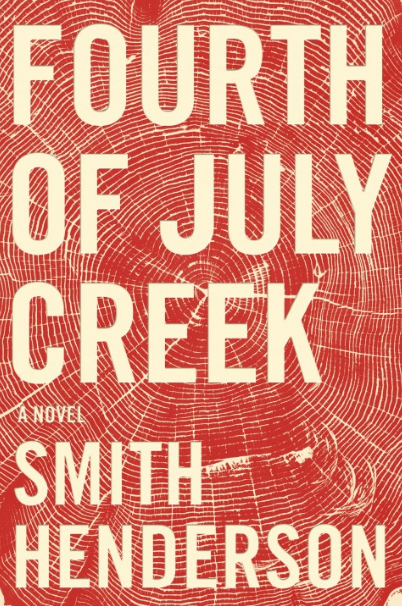Book by SMITH HENDERSON
Reviewed by

Number two on Kurt Vonnegut’s famous eight-item to-do list for fiction writers is: “Give the reader at least one character he or she can root for.” But not too much, one might add. Smith Henderson strikes the balance between likeable and unlikeable admirably in the protagonist of his debut novel Fourth of July Creek. Set in rural Montana, the novel follows Pete Snow, a social worker who rescues children from abusive and dysfunctional families. We like Pete. He gets kids out of dangerous houses with drug-dealing parents, as seen in the novel’s opening scene in which Pete responds to a domestic dispute between one of his clients, teenage Cecil, and his speed-addicted mother—Cecil’s on the roof of the house, Mom’s shooting at him with a pellet gun.Pete knows that this is noble work without being self-righteous about it. He’s funny. When the officer tells Pete that Cecil knocked himself out running into the tailgate of a pickup truck, Pete’s sole response is, “I imagine that was satisfying.” But as the novel progress, we begin to dislike him, too. He slugs Cecil in the stomach. He admits to alcoholism but does nothing about it. We’re not talking about quiet tippling here. He drinks himself into violence, punching out his own car windows on one occasion, then blacks out. He can be a bit of a misogynist.
We like Pete as the main plot of the novel develops. It centers on Pete’s efforts to gain the trust of Jeremiah Pearl, whose antigovernment, apocalyptic, paranoid delusions have driven him and his family into the wilderness. Pete meets the family when Jeremiah’s twelve-year-old son, Benjamin, wanders onto the local elementary school playground. Not recognizing the kid, the principal calls Pete, who coaxes Benjamin into his car and gives him new clothes to replace the threadbare ones he’s wearing. Benjamin eventually directs Pete up an abandoned logging road in the Montana hinterlands. After a miles-long hike up the mountain, Pete meets the ungracious Jeremiah, who orders his son to discard the new clothes, tackles Pete, and opines that he’ll “put one in that boy’s brain before I let you have him.” Pete regains his bearings, and the following scene closes out the chapter:
Pete could still hear them moving across the mountainside and the boy sobbing, and Pearl saying something to him, not harshly, something trim and measured. Pete’s impression of it was that they were scared, as if they’d had the same nightmare and he was assuring the boy that they were awake now, that everything was okay.
He listened until they were gone. Then he gathered the clothes, folded them, put a business card in the pocket of the pants, and set them under a cleft in a rock where they would be dry and could still be seen. He walked carefully down through the dark woods to the road and to his car.
Another day at the office.
Eventually, Pete gains Jeremiah’s trust, delivering sturdier clothes, food, and medicine.
This closing typifies the writing in Fourth of July Creek. The third-person narrator channels Pete’s smartassery in the face of craziness. It makes us admire the book and Pete, and it infuses the novel with realism. I’ve seen it in my mother, a retired social worker. It’s a way of dealing with secondary trauma, a phenomenon that plagues social workers, therapists, teachers, anyone who works with victims of any description. The Montana setting of this novel, along with its time (the first election of Ronald Reagan) underscores Pete’s struggle to infuse a little decency into the lives of his clients. Though Henderson never explicitly connects Pearl’s paranoia to the rise of the neoconservative movement in 1980, the history seems both relevant to the story and meaningful in the contemporary context. The Republican Party of 1980 was liberal compared to today’s version, but the message that America was under siege both from foreign enemies and big-government continues to fuel the paranoid streak in the rural states. Jeremiah’s frontier stoicism swirls with extremist distrust. He sees all of American society, especially its government and agents (even, maybe especially, do-gooders like Pete Snow) as threats. When Pete visits the Pearl family, he is literally and metaphorically traveling alone into unfriendly territory. Pearl has made it known to all that he wants no contact with the outside world—chasing some young pot-growers off his land with well-aimed warning shots from his rifle, for instance. Yet Pete invades Pearl’s airspace armed only with kindness and compassion. He spends a few nights in the woods with them, begins making regular deliveries of food, clothing, and medicine. Interestingly, as Pete makes headway with the Pearl family, the rest of his life is falling apart. His brother is in trouble with the law; his crumbled marriage threatens his relationship with his daughter, Rachel, who runs away halfway through the novel; the love he finds has more skeletons in her closet than a taxidermist.
So, why is Pete able to gain ground with the Pearls yet lose touch with his other clients and his family? What is Henderson’s point in allowing him this success? I’ll hazard a few guesses to this question. First, Henderson wants to show us the haphazard nature of social work. There are few, if any, predictors that a social work client will overcome their situation or relapse back into whatever crazy got them the referral in the first place. As the son of a social worker, and as a teacher myself, I have firsthand knowledge that the client/student must want to improve. Sometimes, the work just won’t stick. Whatever stability is presented is shunned for the comfortable chaos. This is why Cecil runs away; normalcy makes him uneasy. Pearl’s “stability” with his son Benjamin serves as a nice foil for Rachel’s own dysfunction with her father: interesting that the delusional man living in the woods has a better relationship with his child than the man who fixes people for a living has with his.
Second, the character of Jeremiah Pearl, with young Benjamin in tow, is absolutely fascinating. I personally love conspiracy theories and the wackos who adhere to them, so to hear Pearl accuse Pete of being a spy just because a plane passes overhead engrosses me endlessly. Lots of good writing about messed up childhoods exist. Mary Karr and Kaye Gibbons have given us real and fictitious stories about kids in awful circumstances, but to present a likable paranoid homesteader is fairly unique.
And in Pete’s other cases, things take a bad turn. Cecil runs away and, after Pete tracks him down, gets thrown into a juvenile detention facility. Most chapters touch on several subplots, but Henderson does a good job of making Pete’s life complicated without confusing the reader. This structural device reflects Pete’s character. He does a good job of compartmentalizing his life—he doesn’t fret about his brother while he’s looking for his daughter, for example.
Most chapters focus on Pete, but Pete’s thirteen-year-old daughter, Rachel, gets her own chapters, most of which appear early in the narrative and seem to look back on the events of the rest of the book. She seeks solace after her parents’ divorce in sex and drugs, then runs away. The Rachel chapters are unconventional. Borrowing from Joyce and others, Henderson reveals Rachel’s predicament via question-and-answer sessions. Though he never identifies the questioner or the respondent, we sense that Rachel is both and that she is using the format of the social worker’s intake interview—the stock tool of her father’s trade—to look back at the events of the rest of the book.
Rachel’s prose is impressionistic, something of a relief from the vivid, fast-paced writing in the other chapters. This change of style, voice, and pacing makes sense because Rachel isn’t directly involved in the story she’s telling. She’s lived through this already. At this remove, she feels free to elaborate on and interpret her turbulent past. Here’s an example. (The unnamed questioner’s words are in bold type.)
Then what?
Caught a ride west in a Volkswagen split window chasing the Dead. Kansas City to St. Paul to Denver. A few weeks at a commune outside of Boulder. Swimming. Sunning. The mountains again. A feeling of home to it, but no family, just whoever was around, she tried to be useful, she lent a hand until she felt like it was time she moved on.
Where did she stay?
She stayed where there were parties and if there were no parties, she stayed where there had been a party and then with someone who’d been at the party. She sought out fellow travelers.
Did that work?
More or less. There were detours, but then could you call them detours if you weren’t headed anywhere?
We know that the questioner isn’t her father, but the similarity between these questions and the ones Pete asks his clients is strong. The questions are neither judgmental nor leading: they are intended to let Rachel tell her story without inducing any more shame than what she feels.
To borrow language from high school math tests: think about Pete’s and Rachel’s separate narrations as two trains headed to the same station. Rachel’s chapters have already gotten there via a parallel track, and she’s now recounting her journey. Pete, on the other hand, is careening down the rails and isn’t entirely sure where the brake lever is. Without giving away the ending, you’ll be happy to know that the story does not end in a “train wreck.” Social work is filled with joy and terror and wonder and exhaustion. My mother’s last case involved an abandoned baby, who was adopted by a lovely couple, and the police detective who found the infant is now the kid’s godfather. You could call it bleakness swirled with brilliant hope. That’s what Smith Henderson gives us.
James Dickson teaches English and Creative Writing at Germanton High School in Madison, MS.



